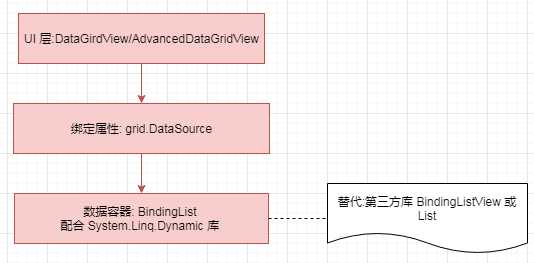DataGridView 组件非常适合和 Ado.Net 的 DataTable 绑定, 网上有很多这方面的使用说明. 在这篇博客中主要关注 DataGridView 和 List 数据对象的绑定.
下图展现了多种绑定的组合方案.

==============================
最佳搭配组合
==============================
这里的红色组合就是最优方案, 采用BindingList作为数据容器, 优点是, 对容器增删改会直接反映到Grid视图层.
但对BindingList容器元素进行sort或 filter, 并不会重新刷新grid视图层,需要重新绑定.
同时, BindingList 容器支持 sort 和 filter 本身会很麻烦, 这时我们可以借助 System.Linq.Dynamic 第三方库, 该第三方库提供提供 list.Where(string predication) 扩展函数, 非常类似动态拼SQL where子句的功能, 举个例子:
var query = Customers.Where("City == ‘SomeValue‘");
==============================
使用 DG.AdvancedDataGridView 替代 DataGridView
==============================
AdvancedDataGridView 不是 .net 内置的类, 可以 nuget 搜索 AdvancedDataGridView 名, 我下载的是 DG.AdvancedDataGridView .
项目主页在 https://github.com/davidegironi/advanceddatagridview
为什么要使用 AdvancedDataGridView, 因为该组件提供类似于 Excel 行过滤的效果, 可以实现过滤行和对组合排序效果.
AdvancedDataGridView 派生于 DataGridView 组件, 提供很多 DataGridView 属性和事件, 其中有两个事件专门用于组合排序和行过滤, 它们分别是 SortStringChanged() 和 FilterStringChanged(). 下面着重看看这两个事件的参数格式:
SortStringChanged()事件中排序事件参数 e.SortString 属性的内容类似于: [Name] asc , [Age] desc
FilterStringChanged()事件中排序事件参数 e.FilterString 属性的内容类似于:
([Name] IN (‘A str‘, ‘B str‘)) AND ([Age] IN (10, 20))
不难看出, AdvancedDataGridView 组件看起来初衷专门用于和 Ado.Net 的 DataTable 绑定, 这样的参数对于非 DataTable 的数据源支持的不好, 需要做一些特殊处理才行.
幸运的是, github 上已经有人给出了完美的解决方案, 具体参考下面文件的 SortStringChanged() 和 FilterStringChanged() 函数.
https://github.com/OceanAirdrop/AdvancedDataGridViewDataModel/blob/master/AdvancedDataGridViewDataModel/Form1.cs
原文:https://www.cnblogs.com/harrychinese/p/datagridview.html